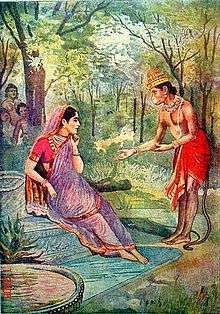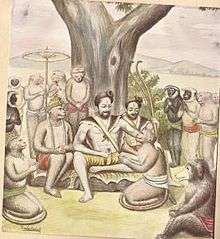Sundara Kanda
| Sundara Kanda | |
|---|---|
 Hanuman visiting Sita in Ashok Vatika, bazaar art, early 1900’s. | |
| Information | |
| Religion | Hinduism |
| Author | Valmiki |
| Language | Sanskrit |
| Part of a series on |
| Hindu scriptures and texts |
|---|
 |
|
Rig vedic
Sama vedic Yajur vedic Atharva vedic |
|
Other scriptures |
| Related Hindu texts |
|
|
Timeline |
Sundara Kanda (IAST: Sundara Kāṇḍa, lit. beautiful episode), is the fifth book in the Hindu epic, the Ramayana. The original Sundara Kanda is in Sanskrit and was composed by Valmiki, who was the first to scripturally record the Ramayana. Sundara Kanda is the only chapter of the Ramayana in which the hero is not Rama, but rather Hanuman. The work depicts the adventures of Hanuman and his selflessness, strength, and devotion to Rama are emphasized in the text. Hanuman was fondly called “Sundara” by his mother Anjani and Sage Valmiki chose this name over others as the Sundara Kanda is about Hanuman's journey to Lanka.
Plot

The Sundara Kanda forms the heart of Valmiki's Ramayana and consists of a detailed, vivid account of Hanuman's adventures. After learning about Sita, Hanuman assumes a gargantuan form and makes a colossal leap across the ocean to Lanka after defeating Surasa, the Mother of the Nagas and Sinhika, who is sent by the Asuras.
In Lanka, Hanuman hears Rama's chant from Vibhishana. Vibhishana recognizes Hanuman as a devoted Ram Bhakt( Devotee). From Vibhishana, Hanuman comes to know location of Sita in Ashok_Vatika.
In the Ashok Vatika, Sita is wooed and threatened by Ravana and his demon mistresses to marry Ravana. He reassures her, giving Rama's signet ring as a sign of good faith. He offers to carry Sita back to Rama, however she refuses, reluctant to allow herself to be rescued by any one, other than her husband. She says that Rama himself must come and avenge the insult of her abduction.
Hanuman then wreaks havoc in Lanka by destroying trees and buildings, and killing Ravana's warriors. He allows himself to be captured and produced before Ravana. He gives a bold lecture to Ravana to release Sita. He is condemned and his tail is set on fire, but he escapes his bonds and, leaping from roof to roof, sets fire to Ravana's citadel and makes the giant leap back from the island. The joyous search party returns to Kishkindha with the news.
The act of reading
It is traditional to begin the reading (pārāyaṇa) of the Ramayana with the Sundara Kanda.[1]
This lesson is recited by religious Hindus, preferably on Tuesdays or Saturdays, these days having been earmarked for special prayers to Hanuman. It happens to be for nullification of the malefic effects of the crow mounted, the son of Surya and Chhaya (Shadow), Lord Shani. Ramayana reveals that Shani Dev, who was captive at Ravana's palace, was rescued by Lord Hanuman. As a token of thanks, Shani Dev offered reprieve to all devotees of Lord Hanuman. Alternately once Shani Dev was caught between Hanuman's shoulders and the ceiling when attempting to mount the latter to influence his stars. Unable to bear the pain, Shani Dev offered gratitude in return to an immediate release.
The religious faith suggests that its recital brings harmony to the household. Many Hindus believe that if one does not have time to read the whole Ramayana, one should read the Sundara Kanda.
Other versions
Multiple variations of the Sundara Kanda exist in other languages as well, for instance in Awadhi, the language in which the saint Tulsidas wrote the Ramacharitamanas. The Sri Ramacharitamanas was written much later than Valmiki's Ramayana, in the 16th century.
An earlier Tamil version, Ramavataram, by Kambar is also a prevalent text among the Sri Vaishnava and Smartha Brahmins in South India.
Ranganatha Ramayanam a Telugu version of valmiki Ramayan written by Gona Budha Reddy also described very well.
M. S. Ramarao wrote Telugu version for Hanuman Chalisa of Tulsidas and Sundara kanda of Valmiki Ramayana as 'Sundarakandamu' in Telugu during 1972-74. He sang Sundarakanda in the form of Telugu songs.
Hanuman Chalisa is a different poetic contribution towards the heroics of Hanuman by the poet, Tulasidas. Though it mentions his achievements during Ramayana, it goes beyond that as well, encompassing the complete life of Hanuman.
References
- ↑ Robert P. Goldman; Sally Sutherland Goldman, eds. (1996), The Ramayana of Valmiki: An Epic of Ancient India : Sundarkand, Princeton University Press, pp. 80–82, ISBN 978-0-691-06662-2
External links
| Wikisource has original text related to this article: |
.jpg)